The landscape for Go-to-Market (GTM) will be changing over the next 12 months in terms of roles within GTM, in combination with how buyers make purchases and the decision-makers involved.
During Workshop Wednesday, held every Wednesday at 10 a.m., Mandy Cole, Partner at Stage 2 Capital, shared the five steps every company needs to take to build their first GTM playbook centered around the buyer.
Traditional Sales Teams Vs. Modern Sales Teams
Traditionally, most people learned to sell by taking a product, showing the sales team with a demo of how to use it, and then sending them off to sell it.
The reality is that the way we sell now should be focused on the buyer.
If we’re designing a process that will work well, it needs to start with the buyer. This is even more important today because there’s more information out there that the buyer has access to before ever having a conversation with the seller. The last few years and the days of pure, cold outbound from a list of unknown names won’t work anymore because buyers are inundated with too many emails.
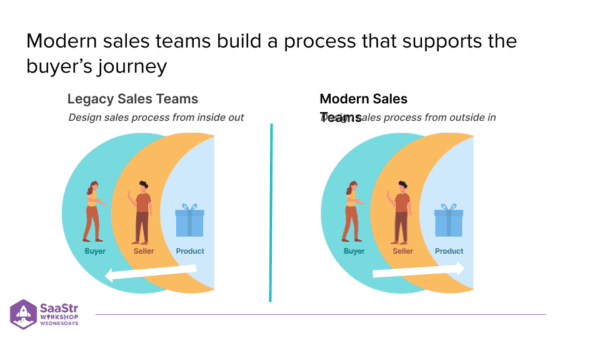
What you need to do instead is leverage more content and intent data. Buyers want to do their own investigating first — looking at materials and determining when they want to engage with the seller.
Where we see success is when a company has a sales process that starts with:
- How the buyer is thinking about it
- How they would purchase your product
- And then mapping the sales journey to that
That’s the basics of how you’ll build your first GTM playbook. Let’s start at the beginning — with the customer.
Step 1: Identify Your Ideal Customer Profile (ICP)
Who are you selling to? What is your Ideal Customer Profile? Let’s look at common mistakes in SaaS GTM playbooks and what to focus on instead.
First, determine the right ICP. Once you get past the founder stage and have your first 10-20 customers, it’s all about focus. You have enough customers to realize there’s a fit, or you’re starting to get initial traction, and that’s where you focus.
Now, you have to determine the key criteria you’ll focus on. Equally important is what you aren’t going to focus on. The more you leave things open, the more other customers bleed in. This can lead to making changes to the product, longer sales cycles, and not focusing on the right customer for your product.
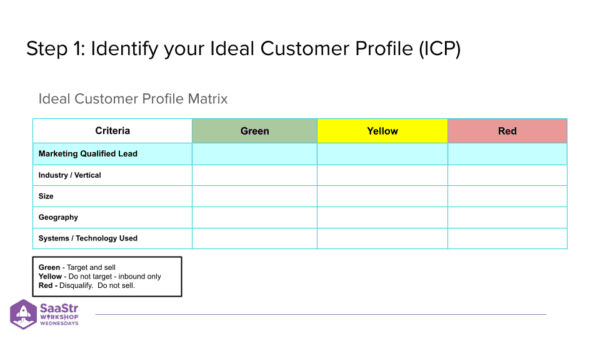
Stage 2 Capital uses a Green/Yellow/red scenario.
- Green is a “go after them.” They’re ideal, and you’ll sell them.
- Yellow is you’re not going to outbound them. But if they happen to come through an inbound channel or referral, you’ll see if they meet the criteria.
- Red is a no-go. They don’t match the product, and it won’t sell.
Red is where a lot of edge cases come in. The more clear you can make this for yourself and your company and sales team if you have one, the easier it is to focus on the green.
Step 2: Define Your Buyer’s Journey
You potentially have several buyers or roles within the buyer’s journey, and the template above defines who the buyer is and what their role in the journey is.
If you’re an SMB, sometimes you only have one person to talk to, maybe the Founder and/ or CEO. If it’s mid-market or Enterprise, sometimes there’s a champion, technical buyer, and decision-maker. Sometimes, there are several folks you’re talking to, and you want to make sure that you’re defining each of their journeys because what they’re looking for could be different.
At Zenefits, Mandy had a user who was an HR Manager, but the decision-maker was the CFO. They had very different reasons for buying the product — different challenges, goals, and what they were looking for. You want to make sure when reaching out that the content (the questions and conversations the salesperson is having) is relevant to the person you’re talking to.
That’s why we’re defining the buyer’s journey.
- What are the challenges?
- Why do they need the product now?
- What else are they considering?
- How are they going to make the decision?
- What’s a must-have and nice-to-have?
- What is their timing?
- What is their definition of success?
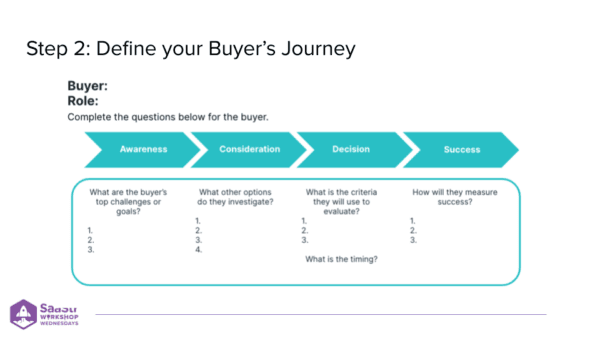
Let’s look at an example. Most Everyone Knows OpenTable. OpenTable’s ICP (not the end-user) is likely a GM or Operations Manager at a restaurant, and that buyer is a decision-maker. Sometimes, they’re also a user, but not always.
What is their goal?
- To make money
- To fill seats
- To reach new customers and bring back old ones
- To optimize capacity in the restaurant and scheduling around that
What could help with this? They could ask other restaurant GMs, look at what they’re using now, and see what’s available to solve their problem. You want to get into the buyer’s head, think of what they’d consider, and how they would feel about them. Think about where your content will be, how you’ll approach them with your message, and what channel.
Some of the decision criteria for this ICP are:
- Whether it integrates with their POS system.
- Whether they have access to new customers
- If it’s usage-based pricing rather than a flat fee.
You want to align on what success means for them and deliver on it. Otherwise, you’ll have a retention problem. So, with the buyer’s journey in place, how do you teach your team to sell to the buyer’s journey?
Step 3: Develop Guides to Support the Buyer’s Journey
This is where you align “playbooks” around each section of the buyer’s journey. For awareness, you want your team to understand how to reach out and the right way to do it, especially if it’s outbound.
If marketing is doing outbound and putting content out there, you want to understand when the sales team will engage. A lot of folks are using intent data and are testing only outbound once someone has landed on their website.
Discovery is clear once they’re considering it. You want to create a guide to help them understand more about the company and help them to make the right decision. Then, ensure the Customer Success team can help manage that customer to success.
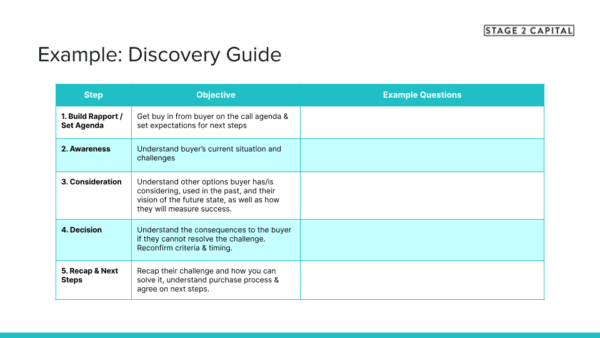
In a discovery guide, you want the objective for each stage in the buyer’s journey, plus example questions. You can encourage your team to make it their own so it’s more authentic than having a script. The real importance for the team is to get into the buyer’s head.
- What is their current situation?
- What are their challenges?
That part is easy. It gets a little more challenging when you ask what they’ve used in the past, why they did or didn’t like it, and how they will measure success against it. The person you’re talking to is likely tied to the success of the business, so you need to figure out what the impact is on the business if you don’t solve their problem.
Next, you’ll want to align all of this with your CRM.
Step 4: Align Your Sales Process to the Buyer’s Journey
This is where the importance of managing pipeline and forecasting comes into play. In many cases, how we manage someone through CRM is focused on what a sales rep is doing and not where the buyer has been.
That’s fine as long as you know where it maps back into the buyer’s journey. Stage 2 Capital has seen it go as far as a company renaming the stages of the funnel to the buyer’s journey. The important thing is to have criteria in each stage based on what the buyer does and not what the seller does.
The seller needs to know what they’re doing, but you want to forecast based on if a buyer is taking action. It removes a lot of the fool’s gold from the forecast.
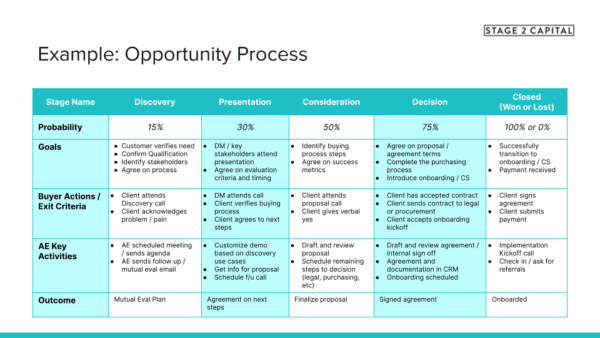
This way, reps understand that the goal isn’t to move people forward but to engage and understand who will move forward and give them the ability to say no. That it’s ok if it isn’t a fit. You want to move out the customers who aren’t a fit so you can focus on the ones who are.
Step 5: Measure and Iterate
This is not a set-it-and-forget-it activity. Things will continue to change. Playbooks often don’t work because people write them down, tuck them away in a Google Drive, and no one uses them again.
It’s hard to understand what’s working and not working if you don’t keep your playbook up to date. Mandy recommends you do this quarterly. Go through and see if it’s what you’re doing in the field, and if it’s not, update it to see the impact on pipeline.
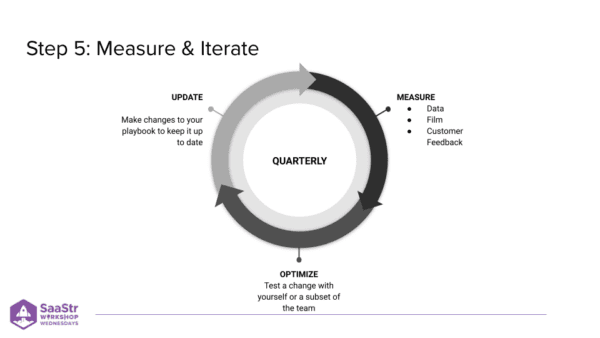
Key Takeaways
- Your sales playbook and process should be defined by your buyer’s journey.
- By using the buyer’s journey framework, you can identify when you are aligned and misaligned with your buyer, and how to differentiate yourself when you are aligned.
- Your sales playbook should including four guides: prospecting, discovery, presentation and customer success to standardize how your team moves a buyer through the journey while focusing on spending more time understanding the customer’s pain points vs. “pitching”.
- Run film reviews to continue to optimize your playbooks and incorporate best practices.
- Customize your CRM stages to align to the buyer journey with entry and exit criteria that is driven by the buyer’s actions, not just your sales rep’s actions.
The post 5 Steps to Build Your First GTM Playbook with Stage 2 Capital appeared first on SaaStr.
via https://www.aiupnow.com
Amelia Ibarra, Khareem Sudlow
